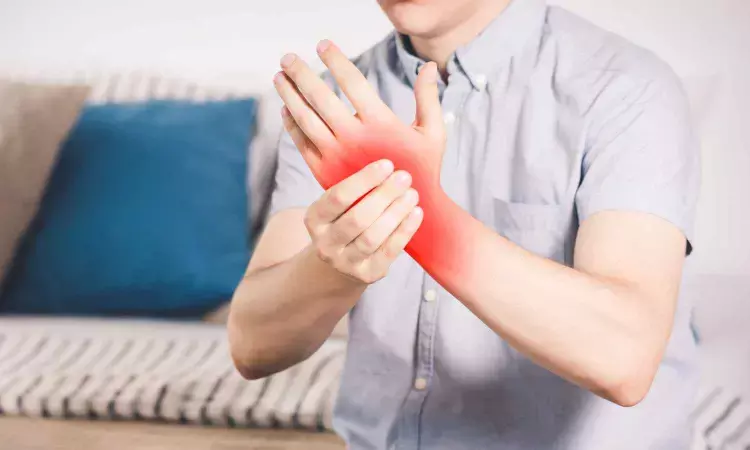- Home
- Medical news & Guidelines
- Anesthesiology
- Cardiology and CTVS
- Critical Care
- Dentistry
- Dermatology
- Diabetes and Endocrinology
- ENT
- Gastroenterology
- Medicine
- Nephrology
- Neurology
- Obstretics-Gynaecology
- Oncology
- Ophthalmology
- Orthopaedics
- Pediatrics-Neonatology
- Psychiatry
- Pulmonology
- Radiology
- Surgery
- Urology
- Laboratory Medicine
- Diet
- Nursing
- Paramedical
- Physiotherapy
- Health news
- Fact Check
- Bone Health Fact Check
- Brain Health Fact Check
- Cancer Related Fact Check
- Child Care Fact Check
- Dental and oral health fact check
- Diabetes and metabolic health fact check
- Diet and Nutrition Fact Check
- Eye and ENT Care Fact Check
- Fitness fact check
- Gut health fact check
- Heart health fact check
- Kidney health fact check
- Medical education fact check
- Men's health fact check
- Respiratory fact check
- Skin and hair care fact check
- Vaccine and Immunization fact check
- Women's health fact check
- AYUSH
- State News
- Andaman and Nicobar Islands
- Andhra Pradesh
- Arunachal Pradesh
- Assam
- Bihar
- Chandigarh
- Chattisgarh
- Dadra and Nagar Haveli
- Daman and Diu
- Delhi
- Goa
- Gujarat
- Haryana
- Himachal Pradesh
- Jammu & Kashmir
- Jharkhand
- Karnataka
- Kerala
- Ladakh
- Lakshadweep
- Madhya Pradesh
- Maharashtra
- Manipur
- Meghalaya
- Mizoram
- Nagaland
- Odisha
- Puducherry
- Punjab
- Rajasthan
- Sikkim
- Tamil Nadu
- Telangana
- Tripura
- Uttar Pradesh
- Uttrakhand
- West Bengal
- Medical Education
- Industry
Carpal Tunnel Syndrome: AAOS Updates Clinical Practice Guideline

The American Academy of Orthopaedic Surgeons (AAOS) issued an update to the Clinical Practice Guideline (CPG) for Management of Carpal Tunnel Syndrome (CTS), which replaces the previous edition from 2016. The guideline was developed to address the diagnosis and treatment of adult patients 18 years of age and older, presenting with complaints that may be attributed to CTS. The updated guideline is streamlined to focus on the long-term benefits of CTS treatment.
“While the 2016 guideline covered several recommendations for the short-term effects of CTS treatment, our workgroup chose to focus on long-term patient outcomes as shifts in healthcare require a focus on cost-effective, high-quality and patient-centered care,” said Lauren Shapiro, MD, co-chair of the guideline development group. “This update provides physicians and patients with clear recommendations to optimize outcomes while minimizing unnecessary interventions.”
CTS is the most common compressive neuropathy affecting the upper extremity. Symptoms such as pain, numbness and tingling in the hand and forearm can lead to morbidity and lost productivity. According to the National Institutes of Health, in the Medicare patient population alone, the burden of CTS accounts for $2.7 to $4.8 billion annually in the United States.
“The CPG was organized to cover workup, treatment and postoperative care of CTS and highlights areas where certain patients can avoid some debatable preoperative treatments (e.g., corticosteroid injections), preoperative tests and postoperative therapies based on the evidence cited in this guideline,” said Robin Kamal, MD, FAAOS, co-chair of the guideline development group.
CTS Diagnosis
The guideline updated the 2016 recommendation to include a strong recommendation on CTS diagnosis, noting that CTS-6, an evaluation tool that accounts for symptoms and disease history, can be used to diagnose CTS. Strong evidence demonstrates that CTS-6 can be used in lieu of the routine use of ultrasonography or a nerve conduction velocity test (NCV) and electromyography (EMG) which can be painful and expensive. Additionally, moderate evidence suggests that MRI and Upper Limb Neurodynamic testing should not be used to diagnose CTS.
Treatment
The CPG supports the notion that both mini-open and endoscopic carpal tunnel release provide similar long-term outcomes for the treatment of CTS and notes the following recommendations for the treatment of CTS:
- The use of platelet-rich plasma (PRP) injections – a new addition to the CPG – and corticosteroid injections both demonstrated a lack of long-term benefits in the nonoperative treatment of CTS.
- Strong evidence showed that local anesthetic alone can be used for carpal tunnel release.
- Limited evidence suggests that carpal tunnel release may be safely conducted in the office setting. Studies consistently demonstrated that there is no increased risk of complications with higher ratings of patient experience and satisfaction when compared to surgical release in the operating room.
Postoperative Care
The guideline also includes the following recommendations and option (guidance formulated with either low-quality evidence, no evidence or conflicting evidence) following surgical treatment:
- Moderate evidence suggests postoperative supervised therapy should not be routinely prescribed after carpal tunnel release.
- Strong evidence suggests that non-steroidal anti-inflammatory drugs and/or acetaminophen should be used after carpal tunnel release for postoperative pain management.
- Limited evidence suggests perioperative prophylactic antibiotics are not indicated for the prevention of surgical site infection following carpal tunnel release.
Additionally, in the absence of reliable evidence, the guideline notes that it is the opinion of the workgroup that no evidence strongly supports the association between high keyboard use and CTS in the literature.
“The recommendations in this CPG highlight areas which are intended for shared decision-making between patients and their physicians and are not meant to be used for insurer determinations,” said Dr. Kamal. “It’s important for patients to understand the risks, benefits, and costs associated with care in the preoperative (testing), intraoperative (anesthesia) and postoperative (therapy) phases of surgical care. As we continue research on the quality, cost, and patient-centeredness of various treatment approaches, our patients and profession will benefit.”
Dr Kamal Kant Kohli-MBBS, DTCD- a chest specialist with more than 30 years of practice and a flair for writing clinical articles, Dr Kamal Kant Kohli joined Medical Dialogues as a Chief Editor of Medical News. Besides writing articles, as an editor, he proofreads and verifies all the medical content published on Medical Dialogues including those coming from journals, studies,medical conferences,guidelines etc. Email: drkohli@medicaldialogues.in. Contact no. 011-43720751


